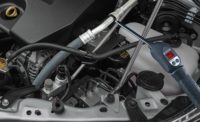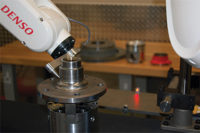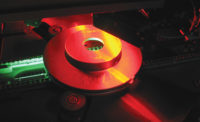
An operator visually inspects an orbital-welded titanium tube for a turbine engine fuel system with a Hawkeye Hardy Borescope. The weld was made less than 1 minute before the inspection. Source: Gradient Lens Corp.
Kreisler Industries (Elmwood Park, NJ) manufactures tube and manifold assemblies for aircraft engines. Kreisler products are used in aircraft such as the Boeing 787 engine and the latest F-35 Joint Strike Fighter. A common characteristic among many of the company’s products is manual and orbital-welded joints.
A build-to-print fabrication company, Kreisler focuses intensely on quality control to achieve its and its customers’ stringent quality requirements. In today’s world of designing for manufacture and implementing lean manufacturing initiatives on the shop floor, Kreisler has found a practical need to bring technology and increased quality to the operator in the manufacturing cell.
According to Kreisler President Michael Stern, “We call a customer return an ‘escape,’ and no level of escapes is acceptable. The passengers, pilot and crew are all counting on us to perform our inspection correctly in order to eliminate any risk to the safety and well-being of the flying public.” For Kreisler, escapes are very expensive, both in monetary terms and in customer satisfaction, and the company has set an aggressive goal of zero customer returns in 2008.
Kreisler needs to identify visual defects as early as possible in the manufacturing process. Doing so provides immediate feedback to the welder or welding operator, reduces the cost of rework and decreases the likelihood of a nonconforming part ever reaching the customer.
To meet its quality requirements, Kreisler has focused on improving its manufacturing process and products with tools such as Six Sigma and lean manufacturing. In addition, to help them better understand customer specifications, all Kreisler’s welders go through a visual training program, with a practical component of visually inspecting actual parts and a technical component of reading specifications and understanding what is acceptable to their customers. Kreisler even occasionally shuts down its plant for a day to discuss quality issues.
Finally, Kreisler employs what Stern terms “very aggressive borescope inspection” in order to detect defects earlier in the manufacturing process. Kreisler uses Gradient Lens Corp.’s (Rochester, NY) Hawkeye Precision borescopes to inspect weld joints, to ensure the quality of the weld is acceptable and that the part is flight-worthy. All of Kreisler’s welders and weld operators have been trained in visual inspection requirements and perform borescopic inspections.
In most cases, operators employ orbital welding with integral filler metal, machined directly into a fitting. They examine each weld to ensure there is no lack of penetration of the weld bead through the parent metal, which typically is titanium, nickel or stainless steel. For instance, the key factor in making high-quality welds in titanium is cleanliness. Thus, inspectors look for weld porosity or contamination.

An operator inspects an orbital weld in a titanium tube with a Hawkeye borescope video system. Video allows for easier viewing and provides image capture capability. Source: Gradient Lens Corp.
Kreisler used to have just one borescope, but the increased complexity of its assurance program demanded additional instruments. Stern says, “With its low-cost lens technology, Gradient has driven down the cost so we can afford to bring borescopes to the cell level and the welder.” The cost of a Gradient Hawkeye Pro Hardy 7-inch rigid borescope incorporating the company’s patented endoGrins gradient index lens system is under $1,000. Ultimately, according to Stern, Gradient has in many ways helped Kreisler bring final inspection into the manufacturing cell.
Kreisler is making its inspection process even more effective with the addition of video systems attached to borescopes. Explains Stern, “The video systems provide blown-up views, so they give inspectors an enhanced picture of welded joints. Welders can just lay down a tube and twirl the scope around to easily and quickly inspect their work. Also, the video system has become a great tool for welder training on visual requirements.”
Kreisler also inspects all welds with X-ray equipment, and an X-ray Level III inspector may use a borescope to confirm something he notices on the X-ray image. Kreisler then sends each part for a final inspection, where the inspector may use the borescope to verify the weld meets specification. The company tracks quality metrics such as customer returns and defect trends. For instance, a nonconforming part is evaluated by Kreisler’s Quality Clinic, which documents a rework procedure signed by quality and manufacturing personnel.
Before borescope inspection, Kreisler’s alternatives to visually inspect parts were a magnifier with a light source or X-ray, which, says Stern, “gets a lot more expensive if we wait to inspect and correct a part at X-ray stage.” Though exact savings are difficult to quantify, using borescope inspection saves Kreisler the cost of the initial X-ray and, if the part is rejected, the re-X-ray of a corrected part. It also saves time in the manufacturing process, which contributes to improved throughput.
“Achieving the highest level of quality is a continuous effort,” says Stern, “and whatever we can do to increase efficiency to the manufacturing cell we will do."
- Gradient Lens Corp.
(800) 536-0790
www.gradientlens.com


